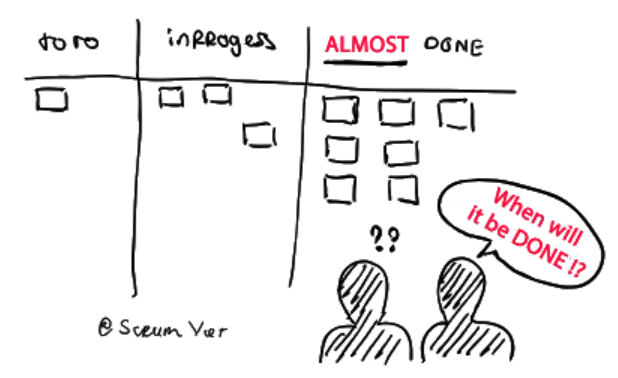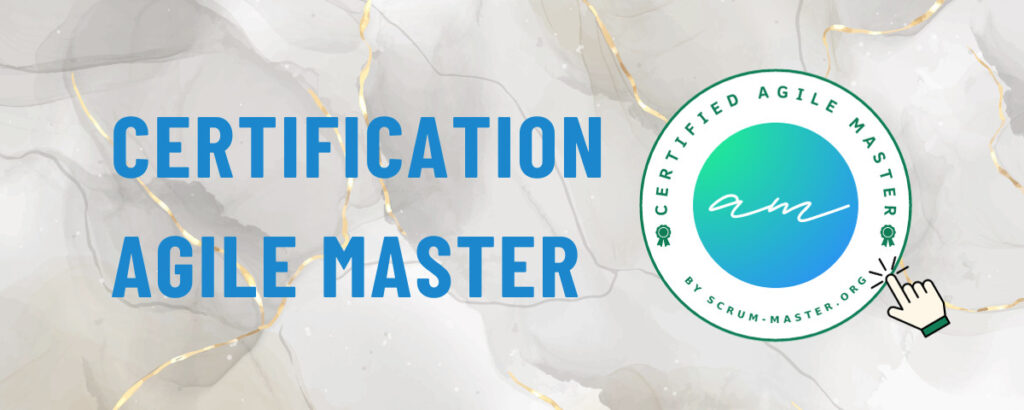The Definition of Done (DoD) stands as a fundamental principle within the Agile and Scrum methodologies, guiding development teams toward a clear understanding of what it means for a task, user story, or product increment to be considered “complete.” This clarity is crucial for ensuring that all product backlog items meet both stakeholder requirements and the team’s quality benchmarks.
In this exploration of DoD, we delve into its significance for Scrum teams, illustrating how it fosters a shared understanding among team members, including the Product Owner, Scrum Master, and developers. We will also cover practical steps for crafting a DoD, the collaborative role each Scrum team member plays in this process, and strategies for effectively implementing DoD to achieve project success.
Whether you’re new to Scrum or seeking to enhance your Agile team’s efficiency and output quality, this article offers valuable insights into DoD and its key role in software development.
Index
What is the Definition of Done (DoD)?
At its core, the Definition of Done establishes a comprehensive checklist of standards and criteria that Scrum team members must adhere to for work to be considered complete. This checklist, essential for maintaining high-quality standards, is visible on management tools like Jira, assisting teams in tracking and ensuring that each product backlog item crosses the finish line with all stakeholder expectations met.
The creation of the DoD is a collective endeavor, requiring input from all corners of the Scrum team. This collaborative process ensures that the DoD is tailored to the specific needs of the project, detailed enough to eliminate ambiguity, and flexible enough to cover a wide array of requirements, from acceptance criteria to increment validations like automated and manual testing, documentation, user acceptance, and sometimes, integration and security specifications.
By delineating what “finished” truly means, the DoD enables Scrum teams to uphold exceptional quality standards, ensuring that every product backlog item not only fulfills stakeholder expectations but is also free from regressions or bugs, thanks to thorough testing before being deemed complete. In essence, the DoD is a critical component of the Agile Scrum methodology, instrumental in both preserving work quality and satisfying stakeholder demands. Its meticulous formulation is key to its effectiveness and utility for the team.

An example of Definition of Done
To illustrate the practical application of DoD, let’s consider an example for a team developing a classic website. A well-crafted Definition of Done for such a project might include:
- All page elements are functional and responsive across devices.
- Text content is proofread, corrected, and aligns with the content strategy.
- Images are optimized for the web and adhere to the graphic charter.
- Cross-browser compatibility is tested and assured.
- Page loading times meet current speed optimization standards.
- The codebase is clean, well-documented, and follows development best practices.
- All unit and functional tests are successfully passed.
This checklist represents a snapshot of the diverse elements that might be considered to ensure a deliverable is truly “done.” It’s crucial that these criteria are specific to the team’s technical and functional environment, allowing for a tailored approach that best suits project needs.

Role of Scrum Team Members in Implementing DoD
The effective implementation of the Definition of Done is a collaborative effort, involving key roles within the Scrum team:
The Scrum Master champions the DoD process, ensuring all team members understand and adhere to its criteria. This role involves facilitating discussions around the DoD, helping the team to update it as necessary to reflect evolving project needs or challenges.
The Product Owner works closely with the development team to define the DoD requirements. This ensures that the DoD aligns with both company objectives and user needs, making it a vital tool for delivering value. The Product Owner also plays a critical role in clarifying any ambiguities in the DoD to ensure it’s comprehensible and actionable for the team.
Development team members are tasked with the hands-on application of the DoD criteria to their work on sprint tasks. This group must ensure that each product backlog item not only meets the defined DoD standards before being considered complete but also engages in continuous dialogue with the Product Owner and Scrum Master to verify that the DoD remains relevant and comprehensive.
In summary, the DoD is a collective responsibility that requires clear communication and shared understanding among the Product Owner, Scrum Master, and development team. Its clarity, comprehensibility, and alignment with organizational goals are fundamental to its success and effectiveness.
Implementing DoD for the First Time in an Agile Team
Initiating the Definition of Done (DoD) within a team, especially one new to Agile practices, requires a structured approach. Here are steps to facilitate a successful DoD workshop:
Introduce the Concept: Begin by explaining the DoD, its purpose, and its importance in ensuring product quality and meeting stakeholder expectations. Utilizing examples can help illustrate its impact on project success.
Identify Quality Criteria: Engage the team in identifying all relevant quality criteria for your project, such as performance, security, and browser compatibility. This brainstorming session ensures a comprehensive list that reflects the project’s needs.
Prioritize the Criteria: Collaboratively prioritize these criteria based on their significance to the project’s success. This step helps focus efforts on aspects that offer the most value.
Draft the DoD: Use the prioritized list to create a detailed DoD that encompasses all agreed-upon quality standards. This checklist will serve as the team’s guide to determining when a task is truly complete.
Validate the DoD: Seek team consensus on the draft DoD. It’s essential for every team member to understand and agree on what each criterion entails and how it applies to their work.
Monitor and Adapt the DoD: Regularly review the DoD to ensure it remains relevant and effective. Be prepared to adapt it in response to new insights, project evolution, or feedback from sprint reviews.
To enhance the interactive experience of defining your team’s Definition of Done, consider organizing a DoD Kards workshop. Based on my experience with this engaging format in previous missions, it not only fosters collaboration but also adds an element of fun to the process. For a seamless start, access and download the DoD Kards in both English and PDF format directly from Coach-Agile.com Drive. This tool is an excellent resource for bringing clarity and shared understanding to your Agile team’s DoD discussions

What's the difference between acceptance criteria and DoD?
While both acceptance criteria and the Definition of Done play crucial roles in Agile and Scrum methodologies, it’s important to understand their differences:
Acceptance Criteria are specific to each product backlog item, detailing the conditions that must be met for the work to satisfy customer needs and receive approval. These criteria are agreed upon before sprint planning and are essential for guiding development with clear, measurable goals.
The DoD, on the other hand, represents a broader set of quality standards and practices that apply universally to all tasks undertaken by the development team. Unlike acceptance criteria, which vary from item to item, the DoD is consistent across the board, ensuring a uniform quality level and completeness for all deliverables.
Understanding and effectively implementing both concepts are vital for Scrum teams to deliver high-quality products that meet both the Definition of Ready and the stakeholders’ expectations. The DoD and acceptance criteria complement each other, providing a dual framework that guides the Scrum team towards excellence in product development.
Wrapping Up
In summary, the Definition of Done (DoD) is an indispensable aspect of the Scrum methodology, playing a pivotal role in ensuring the quality and value of deliverables. It equips the development team with a clear set of criteria for what constitutes “done,” guaranteeing that every product backlog item aligns with stakeholder expectations and adheres to predefined quality and acceptance standards.
The establishment of these criteria, ideally before sprint planning begins, significantly boosts the team’s efficiency and productivity. It streamlines the software development process, mitigating potential risks and preempting issues that could arise later. Thus, the DoD is fundamental in fulfilling Scrum’s mission: the swift delivery of a superior product that not only meets but exceeds the customer’s expectations. Through fostering a shared understanding among Scrum team members, including the Product Owner and Scrum Master, the DoD helps navigate the complexities of product development, ensuring a successful, transparent, and cohesive approach to Agile project management.
Further information
For those keen to explore more about the Definition of Done and delve deeper into Agile and Scrum practices, numerous resources are available to enrich your understanding:
“Scrum – The Art of Doing Twice the Work in Half the Time” by Jeff Sutherland offers insightful perspectives on maximizing productivity within Scrum teams.
“Succeeding with Agile: Software Development Using Scrum” by Mike Cohn provides a comprehensive guide to effective Agile software development, highlighting strategies for success.
“The Lean Startup: How Today’s Entrepreneurs Use Continuous Innovation to Create Radically Successful Businesses” by Eric Ries explores the principles of lean thinking in startup environments, applicable in Agile methodologies.
For a foundational understanding of prerequisites before sprint commencements, our article on the Definition of Ready complements the knowledge of DoD.
These resources serve as a springboard for further learning and application of Agile and Scrum methodologies, empowering you to elevate your software development practices.
We hope this guide has illuminated the path to understanding and implementing the Definition of Done, emphasizing its critical role in the Scrum framework.










